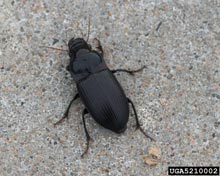
Whitney Crenshaw, Colorado State University

Vegetables and Soybeans in Southeast Asia
Ground Beetles
General Description
Structures with bright lights visible from outside at night are likely to attract these six-legged visitors; and larger
structures, such as commercial buildings that are often well-lighted at night, are particularly susceptible to invasion.
There are many species, but the ground beetles most commonly attracted in large numbers are dull to shiny
black, about one-half of an inch long, and somewhat flat in shape.
These beetles are strong fliers that enter structures through open doors, windows and vents, gaps beneath doors and similar openings. By day they are found dead of exhaustion or resting among the surrounding ground cover, mulch, rock and debris, or in soil and pavement cracks. Larger ground beetles can bite, pinching the skin. Some release foul-smelling defensive secretions, and some species, known as bombardier beetles (Brachinus and others), release irritating chemicals that explode with a popping noise.
General Control
The best method of control is exclusion and to reduce night lighting by shading or switching off lights visible from
outdoors. Treatments with liquid residual pesticides around the foundation perimeter can be effective against
ground beetles if reduced lighting and exclusion fail.









